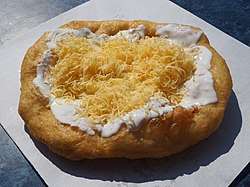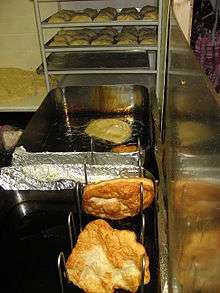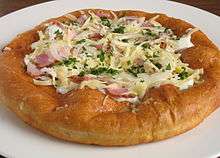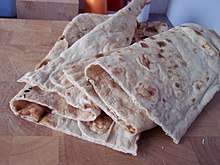Lángos
Lángos (Hungarian pronunciation: [ˈlaːŋɡoʃ]) is a Hungarian food speciality, a deep fried dough.[1][2]
 | |
| Alternative names | Lalanga |
|---|---|
| Type | Raised dough |
| Place of origin | Hungary |
| Main ingredients | Flour, yeast, salt |
Etymology and history

The name comes from láng, the Hungarian word for flame.[3]
The early-15th-century Glossary of Beszterce,[4] the most ancient currently known Hungarian "dictionary", reveals that the ultimate ancestor of flat breads was the panis focacius attributed to the Romans (of which derives also the Italian flat bread called focaccia). In ancient Rome, panis focacius[5] was a flat bread baked in the ashes of the fireplace (cf. Latin focus meaning "fireplace"). The modern lángos, despite its name, is not prepared near an open flame but rather by deep-fat frying, and among Hungarian foods it is instead the pogácsa which preserves the connection, both etymological and culinary, to the ancient panis focacius.
Lalanga was present both in the Byzantine and Ottoman cuisines; whilst in the former it was only eaten as a sweet, in Ottoman Turkey it was eaten both as a sweet dish with honey or as a savoury, with cheese.[6] Lalanga continues to exist in the Turkish cuisine,[7] as well as in the Greek Cuisine (mostly in Peloponnese) as Lalagia (In Greek Λαλάγγια).[8]
Variations

The dough for lángos is made of water or milk, flour, yeast, and salt.[1][2] The ingredients are worked together either by hand or a kneading machine. As the yeast starts to metabolize the carbohydrates in the flour, carbon dioxide is released which causes the dough to rise, creating the air bubbles in the lángos.[9] The dough is basically the same as pizza dough, but it is not baked but fried in oil. Adding sour cream, yoghurt or mashed potatoes to the dough is optional but highly encouraged, in the latter case it is called potato lángos (in Hungarian krumplis lángos).[2] It is eaten fresh and warm, topped with sour cream and grated cheese, or Liptauer, ham, or sausages, or most frequently, without toppings, just rubbed with garlic or garlic butter, or doused with garlic water. Other ingredients and accompaniments can be mushroom, quark cheese, eggplant, cabbage, kefir, omelet, and a confectioner's sugar or jam.
Traditionally lángos was baked in the front of the brick oven close to the flames. This is the basis for its name; "láng" means "flame" in the Hungarian language. Lángos was made from bread dough and was served as breakfast on the days when new bread was baked. Now that people no longer have brick ovens and do not bake bread at home, lángos is virtually always fried in oil.
Lángos is popular all year long. As it is a rather affordable and simple food, it is often sold around bus stations, fairs, and all over Eastern European countries during local celebrations or sport events. It is sold at many fast-food restaurants not only in Hungary but also in Austria. In Austria, especially in Vienna, lángos is very popular as a fast food at fairs and in amusement parks like the Prater. Lángos is known in the Czech Republic, Slovakia and Croatia as langoš, in Serbia as languš (although it is commonly called "Mekike"). In Slovenia is known as Langaš. In Bulgaria it is known as Mekitsi. It is also popular in Romania (especially in Transylvania) as langoși. It is also extremely popular in Poland where it is known as "langosz" and in the UK where it's called "langos" or "Hungarian Fried Bread."
Similar dishes
Lángos is very similar to a version of frybread made by the Indigenous peoples of the Americas. Lángos is also similar to Bulgarian mekitsa, Central Asian shelpek, Indian bhatoora, and Canadian BeaverTails.
See also
References
- "NetCooks - Hungarian Langos Recipe". Netcooks.com. Retrieved 15 December 2017.
- June Meyers Authentic Hungarian Heirloom Recipes Cookbook
- "láng - Wiktionary". en.wiktionary.org.
- "Glossary". Glossary.com. Archived from the original on 22 May 2011. Retrieved 15 December 2017.
- "Italian bread". Italiantourism.com. Archived from the original on 12 July 2017. Retrieved 15 December 2017.
- Marianna Yerasimos (2002). 500 yıllık Osmanlı yemek kültürü: günümüze uyarlanmış 99 Osmanlı yemeği : Osmanlı mutfağı. Boyut Yayınları.
- Türkiye Ekonomik ve Toplumsal Tarih Vakfı (1994). Dünden bugüne İstanbul ansiklopedisi. Kültür Bakanlığı. ISBN 978-975-7306-06-1.
- "Fried dough (Lalagia) | gourmed.com". gourmed.com. Retrieved 2016-08-10.
- "Hungarian lángos". suncakemom.com.
External links


